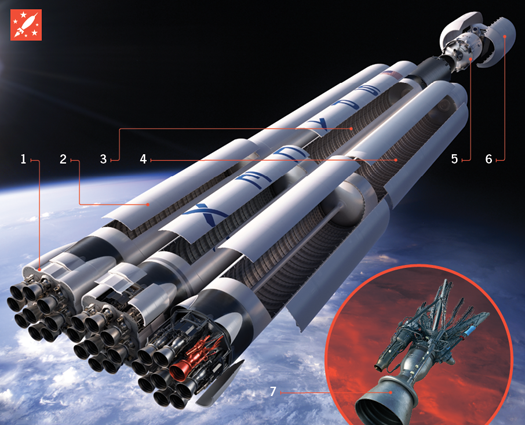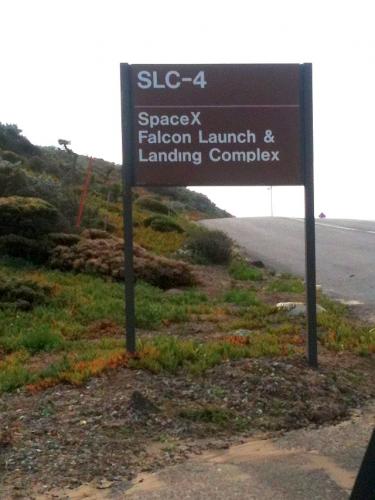Consider this the SpaceX Falcon Heavy maiden flight thread.
Now that the SpaceX Falcon Heavy cores are being prepped for their new large underground test stand at McGregor Texas & shipment to Vandenberg AFB later this year, PopSci and others are starting to cover it.
This is going to be one powerful SOB, and 227 feet tall for the standard fairing. Fully capable of beyond Earth orbit missions, it'll also be human rated & be able to launch the manned DragonRider spacecraft well past the moon.
IMAGES: the engine mounts aren't quite right, and the cores won't have the squared-off corner fairings at the bottom, but pretty darned close.
Also: they didn't mention that in a reusable version the cores will be flying back to vertical propulsive landings near the launch site.
Another omission is that unlike most rocket engines whose chambers are machined & plated, the Merlin 1D's chamber & upper nozzle are explosively hydroformed. Not one-offs, Merlin 1D's are made on a production line - up to 700 / year.


Now that the SpaceX Falcon Heavy cores are being prepped for their new large underground test stand at McGregor Texas & shipment to Vandenberg AFB later this year, PopSci and others are starting to cover it.
This is going to be one powerful SOB, and 227 feet tall for the standard fairing. Fully capable of beyond Earth orbit missions, it'll also be human rated & be able to launch the manned DragonRider spacecraft well past the moon.
IMAGES: the engine mounts aren't quite right, and the cores won't have the squared-off corner fairings at the bottom, but pretty darned close.
Also: they didn't mention that in a reusable version the cores will be flying back to vertical propulsive landings near the launch site.
Another omission is that unlike most rocket engines whose chambers are machined & plated, the Merlin 1D's chamber & upper nozzle are explosively hydroformed. Not one-offs, Merlin 1D's are made on a production line - up to 700 / year.
How It Works: The Most Powerful Space Rocket
When the firm SpaceX launches its Falcon Heavy rocket into space late this year, the craft will become the mightiest rocket in the world. Only NASA’s Saturn V, which sent Americans to the moon, has ever generated more power. In rockets, the most important measure of power is thrust. Falcon Heavy’s 27 individual booster engines together generate 3.8 million pounds of thrust—enough to lift the 3.1-million-pound rocket and its 117,000-pound payload toward low-Earth orbit. The rocket’s success is critical for both SpaceX and the U.S. space program: The Air Force has already hired SpaceX and its Falcon Heavy to send two satellites into orbit sometime in 2015.
1) ENGINE CLUSTER
Nine SpaceX Merlin 1D engines sit at the bottom of each of the craft’s three cores, or boosters. The engines are identical to those on SpaceX’s Falcon 9 rocket.
2) FIRST STAGE: THREE ROCKET CORES
Falcon Heavy’s first stage consists of three cores. All three cores operate together at liftoff. About T+2:45 minutes into flight, the center core throttles down while the two side cores continue at full thrust until their fuel is nearly spent. At that point, pneumatic separators release the side cores, which plummet into the ocean, and the center core throttles up.
3) CENTER CORE
For payloads heavier than 100,000 pounds, Falcon Heavy uses a cross-feed system to run fuel from the side cores to the center core, leaving the center core almost fully fueled after the side boosters separate. What’s left is the equivalent of a complete Falcon 9 rocket already high in space.
4) FUEL TANKS
A liquid-oxygen tank at the top of each core feeds the engines through a center tube; the lower portion of the tank contains rocket-grade kerosene. The propellants are turbo-pumped into each Merlin engine’s injector, where they are mixed and fed into the combustion chamber.
5) SECOND STAGE
Powered by a single Merlin 1D engine modified to operate in the vacuum of space, the second stage delivers the final push that gets the payload into orbit. The engine can shut down and reignite as needed, enabling Falcon Heavy to deliver multiple payloads to different orbits.
6) FAIRING
Falcon Heavy can carry either a Dragon capsule—SpaceX’s free-flying spacecraft, currently used to resupply the International Space Station—or up to 117,000 pounds of payload (think multiple military and commercial satellites) enclosed in a shell 45 feet long and 17 feet in diameter. The fairing consists of two clamshell-style halves made of an aluminum honeycomb core and carbon-fiber face sheets. When the second stage nears the desired orbit, pneumatic pushers split the halves apart, exposing the payload.
7) MERLIN 1D ENGINE
A single Merlin 1D generates 147,000 pounds of thrust at sea level, burning rocket-grade kerosene and liquid oxygen fed by a turbo-pump into the combustion chamber. Falcon Heavy’s liquid propellant has an advantage over solid fuel: Liquid-fueled engines can stop and restart in flight, whereas solid-fuel engines burn until they are spent. Through proprietary adjustments that SpaceX won’t disclose, engineers recently lightened the engine to increase its efficiency, making it the most efficient rocket booster engine ever built.
>
> (Countdown & post-launch tick-tock)
>
When the firm SpaceX launches its Falcon Heavy rocket into space late this year, the craft will become the mightiest rocket in the world. Only NASA’s Saturn V, which sent Americans to the moon, has ever generated more power. In rockets, the most important measure of power is thrust. Falcon Heavy’s 27 individual booster engines together generate 3.8 million pounds of thrust—enough to lift the 3.1-million-pound rocket and its 117,000-pound payload toward low-Earth orbit. The rocket’s success is critical for both SpaceX and the U.S. space program: The Air Force has already hired SpaceX and its Falcon Heavy to send two satellites into orbit sometime in 2015.
1) ENGINE CLUSTER
Nine SpaceX Merlin 1D engines sit at the bottom of each of the craft’s three cores, or boosters. The engines are identical to those on SpaceX’s Falcon 9 rocket.
2) FIRST STAGE: THREE ROCKET CORES
Falcon Heavy’s first stage consists of three cores. All three cores operate together at liftoff. About T+2:45 minutes into flight, the center core throttles down while the two side cores continue at full thrust until their fuel is nearly spent. At that point, pneumatic separators release the side cores, which plummet into the ocean, and the center core throttles up.
3) CENTER CORE
For payloads heavier than 100,000 pounds, Falcon Heavy uses a cross-feed system to run fuel from the side cores to the center core, leaving the center core almost fully fueled after the side boosters separate. What’s left is the equivalent of a complete Falcon 9 rocket already high in space.
4) FUEL TANKS
A liquid-oxygen tank at the top of each core feeds the engines through a center tube; the lower portion of the tank contains rocket-grade kerosene. The propellants are turbo-pumped into each Merlin engine’s injector, where they are mixed and fed into the combustion chamber.
5) SECOND STAGE
Powered by a single Merlin 1D engine modified to operate in the vacuum of space, the second stage delivers the final push that gets the payload into orbit. The engine can shut down and reignite as needed, enabling Falcon Heavy to deliver multiple payloads to different orbits.
6) FAIRING
Falcon Heavy can carry either a Dragon capsule—SpaceX’s free-flying spacecraft, currently used to resupply the International Space Station—or up to 117,000 pounds of payload (think multiple military and commercial satellites) enclosed in a shell 45 feet long and 17 feet in diameter. The fairing consists of two clamshell-style halves made of an aluminum honeycomb core and carbon-fiber face sheets. When the second stage nears the desired orbit, pneumatic pushers split the halves apart, exposing the payload.
7) MERLIN 1D ENGINE
A single Merlin 1D generates 147,000 pounds of thrust at sea level, burning rocket-grade kerosene and liquid oxygen fed by a turbo-pump into the combustion chamber. Falcon Heavy’s liquid propellant has an advantage over solid fuel: Liquid-fueled engines can stop and restart in flight, whereas solid-fuel engines burn until they are spent. Through proprietary adjustments that SpaceX won’t disclose, engineers recently lightened the engine to increase its efficiency, making it the most efficient rocket booster engine ever built.
>
> (Countdown & post-launch tick-tock)
>





 Fractal Design Arc Mini R2, 3800X, Asus B450M-PRO mATX, 2x8GB B-die@3800C16, AMD Vega64, Seasonic 850W Gold, Black Ice Nemesis/Laing DDC/EKWB 240 Loop (VRM>CPU>GPU), Noctua Fans.
Fractal Design Arc Mini R2, 3800X, Asus B450M-PRO mATX, 2x8GB B-die@3800C16, AMD Vega64, Seasonic 850W Gold, Black Ice Nemesis/Laing DDC/EKWB 240 Loop (VRM>CPU>GPU), Noctua Fans.





Comment